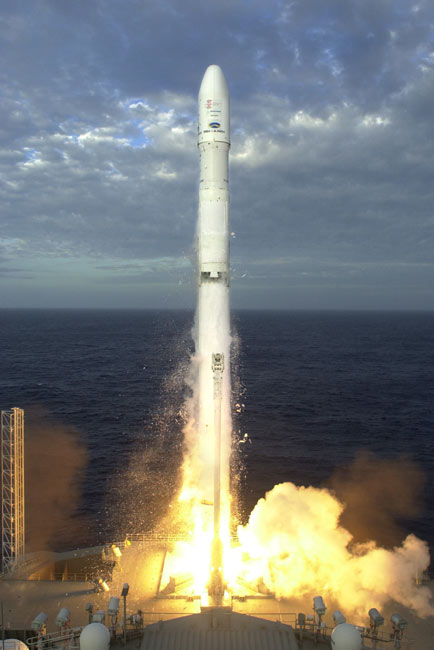Sea Launch Rocket Orbits Radio Satellite

With its popularity growingand new subscribers steadily signing up, XM Satellite Radio successfullydeployed its third broadcasting spacecraft Monday night using a sea-launchedrocket from a platform floating in equatorial waters of the Pacific.
The 20-story Zenit 3SL rocket roared skyward at 0351 GMT (10:51 p.m.EST) after nearly two weeks of delays prompted by bad weather, rough seas andtechnical issues with the booster.
"The launch wasawesome. No matter how many times you see one, you always love to see it,"Derek de Bastos, XM's vicepresident for engineering, said from the launch control ship. "It was agood sight to see after all of this hard work. And it was pretty loud, but I'mnot sure if that was the rocket I was hearing or my own heart pounding in myhead."
The two Ukrainian-madelower stages performed their firings to propel the Russian Block DM-SL upperstage and XM 3 satellite out of the atmosphere during the initial minutes offlight. The upper stage's main engine took over, completing a pair of firingsseparated by a half-hour coast to reach an elliptical geosynchronous transferorbit stretching from 1,534 miles at its closest point to Earth to 22,241 milesat its highest point.
While flying above thecoast of Gabon, Africa, explosive bolts holding the 10,350-poundsatellite to the spent rocket motor were detonated, allowing small springs torelease XM 3. By design, tip-off rates were imparted on the satellite to createa gentle tumble as it moved away at one-foot-per-second.
In the coming days, thespacecraft will maneuver itself into geostationary orbit 22,300 miles above theequator where it can match Earth's rotation and appear parked above 85 degreesWest longitude.
The XM 3 spacecraft is arevised model from its two predecessors, which were deployed in 2001 beforeengineers discovered a crippling design flaw that degrades the power-generatingcapacity as the satellites age. The manufacturer -- Boeing Satellite Systems --removed the faulty hardware and lengthened XM 3's twin solar arrays to overcomethe power problem.
Get the Space.com Newsletter
Breaking space news, the latest updates on rocket launches, skywatching events and more!
The satellites cover theentire lower 48 states, beaming programming to special receiving radios installed in subscribers' cars and portable units that youcan take anywhere.
The system broadcastsdigital programming to subscribers from coast to coast, including 67commercial-free music channels, more than 60 channels of sports, talk, comedy,children's and entertainment programming, and 21 channels of traffic andweather information for select metropolitan areas.
More than 3.2 millionsubscribers listen to XM, which debuted in November 2001, making it the leadingsatellite radio service in the U.S.
"XM'sgrowth to date demonstrates that the potential for satellite radio is fargreater than anyone anticipated," said Hugh Panero,XM's president and CEO.
Earlier Monday, the companyannounced a rate hike, increasing the monthly fee from $9.99 to $12.95beginning April 2.
"This new pricingapproach will help fund future technology development, enable us to offer moreattractively-priced radios and maintain our programming excellence. Together,these initiatives should result in XM exceeding its current target of 20million customers by 2010," Panero said.
Monday's mission was the15th for Sea Launch dating to 1999 and the first since being sidelined by aproblem with the Block DM-SL last summer.
The Odyssey launch platformand the Sea Launch Commander control ship departed home port in Long Beach, California,in early February for the voyage to the equator.
"After the first dayor so you forget about being on a boat. It just becomes work without thecommute," de Bastos said. "We work most ofthe time but every once in a while we had the chance to do some fishing. Wecaught maybe 30 or 40 fish before we stopped counting."
The vessels will head hometo receive the next payload. Sea Launch says it intends to conduct six launchesthis year.
Join our Space Forums to keep talking space on the latest missions, night sky and more! And if you have a news tip, correction or comment, let us know at: community@space.com.
Justin Ray is the former editor of the space launch and news site Spaceflight Now, where he covered a wide range of missions by NASA, the U.S. military and space agencies around the world. Justin was space reporter for Florida Today and served as a public affairs intern with Space Launch Delta 45 at what is now the Cape Canaveral Space Force Station before joining the Spaceflight Now team. In 2017, Justin joined the United Launch Alliance team, a commercial launch service provider.









